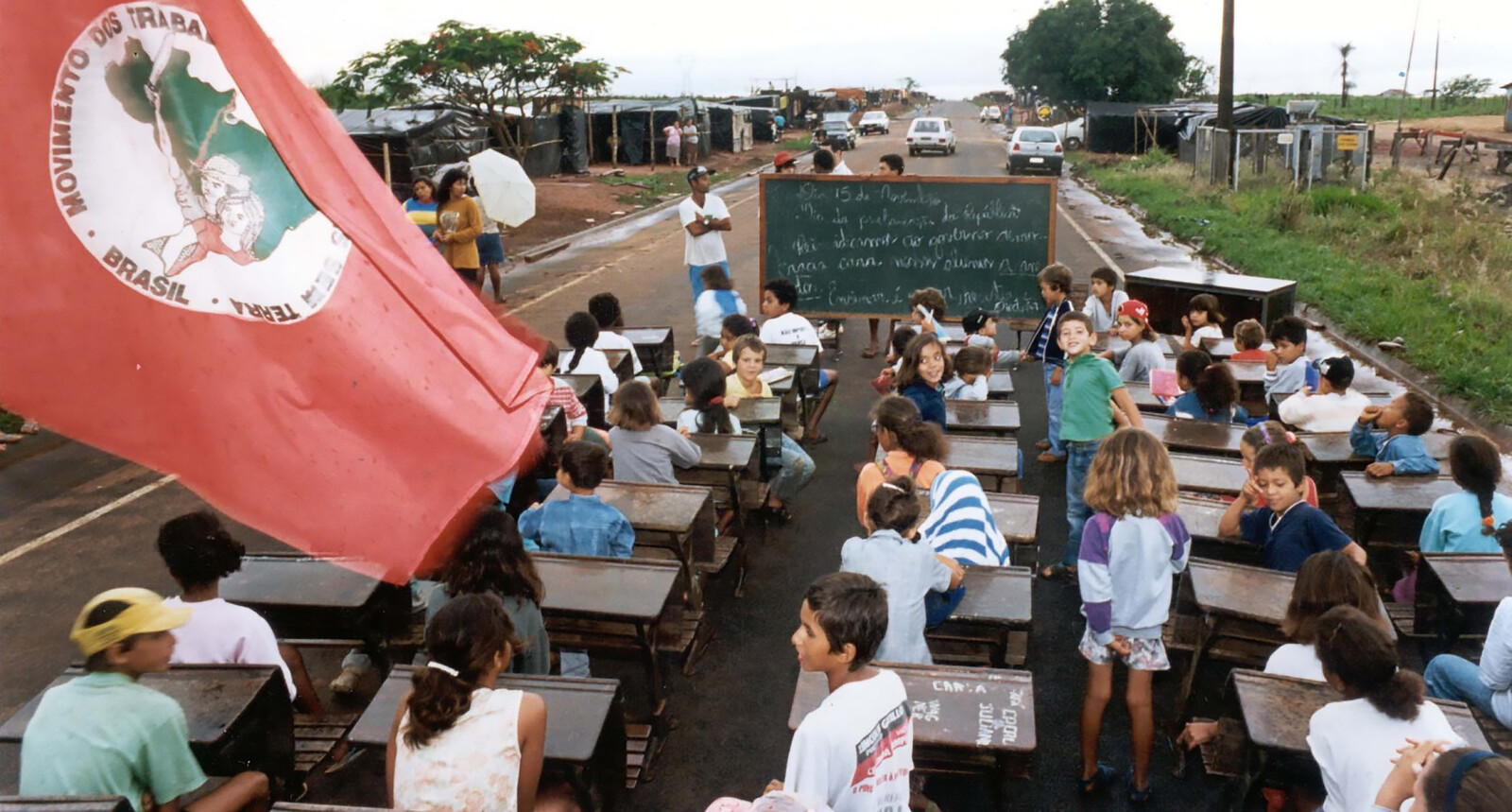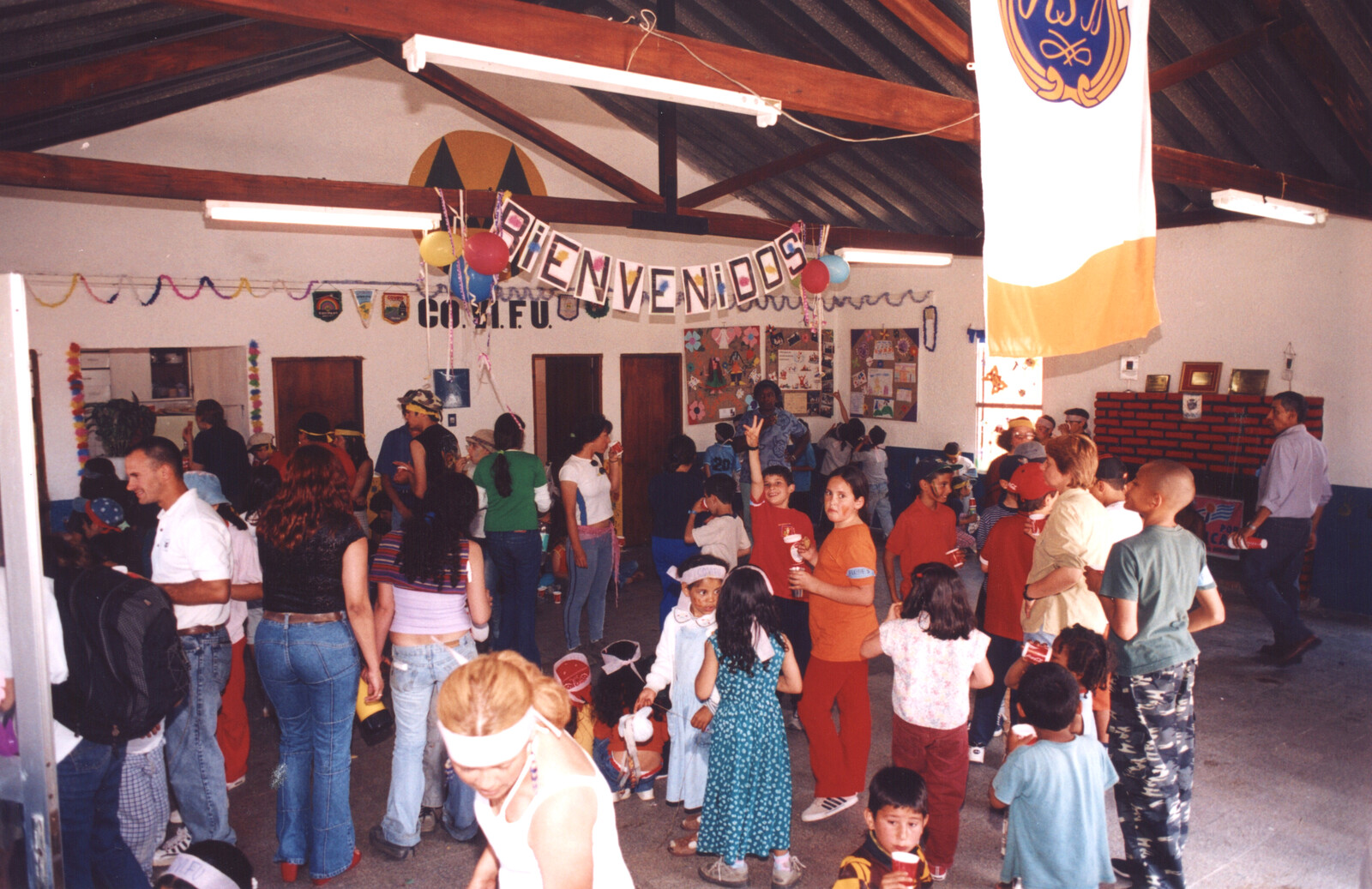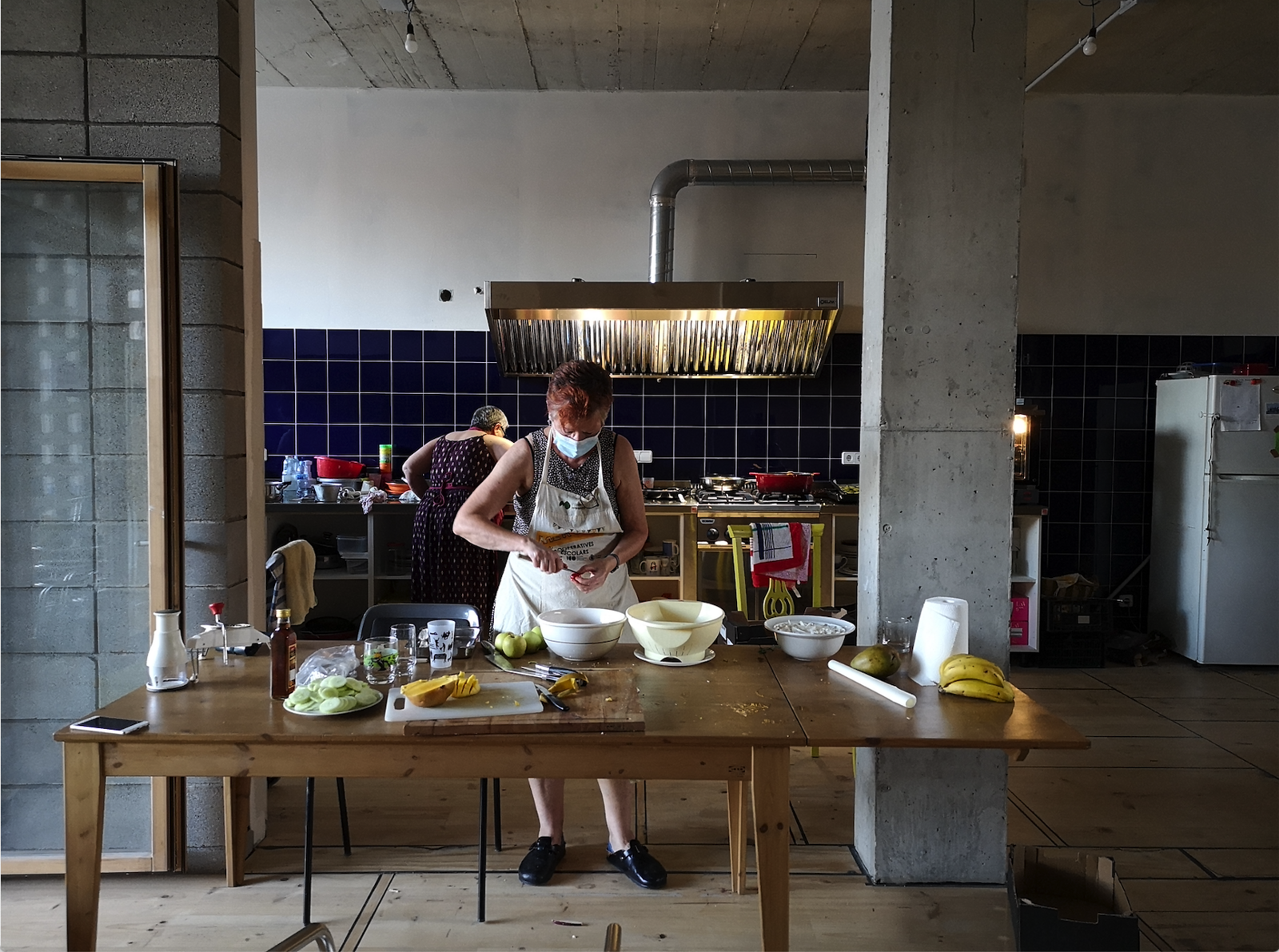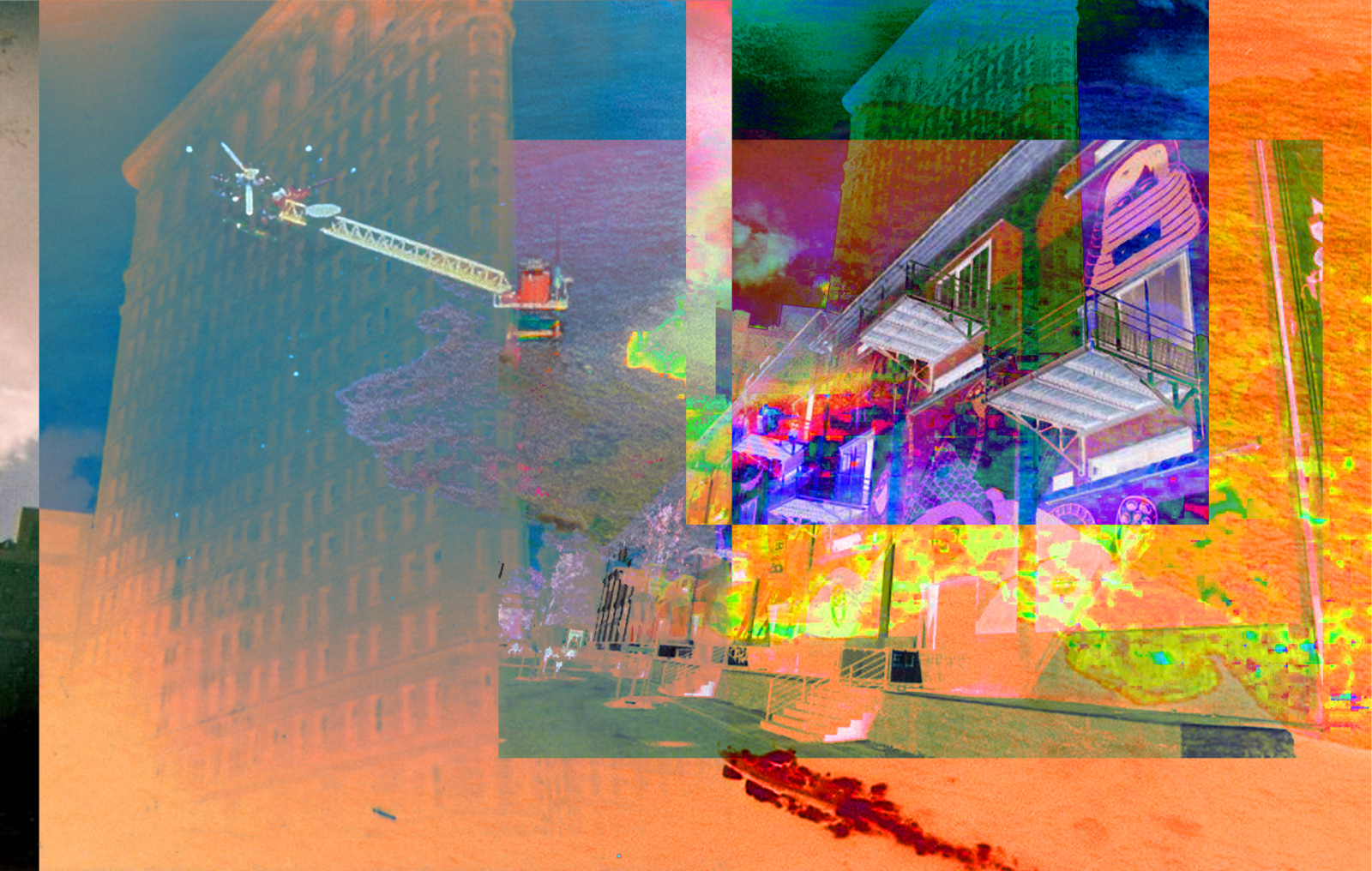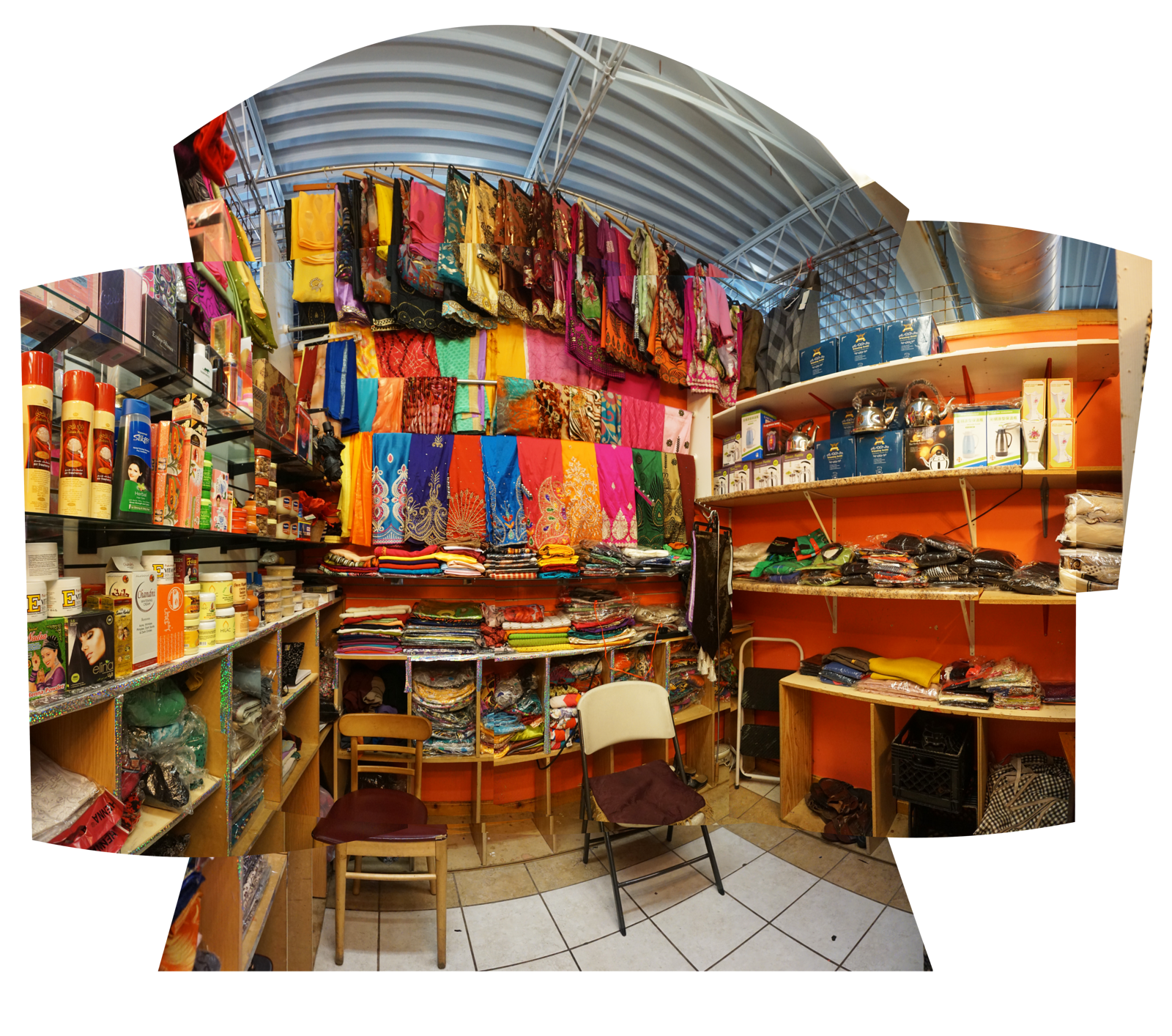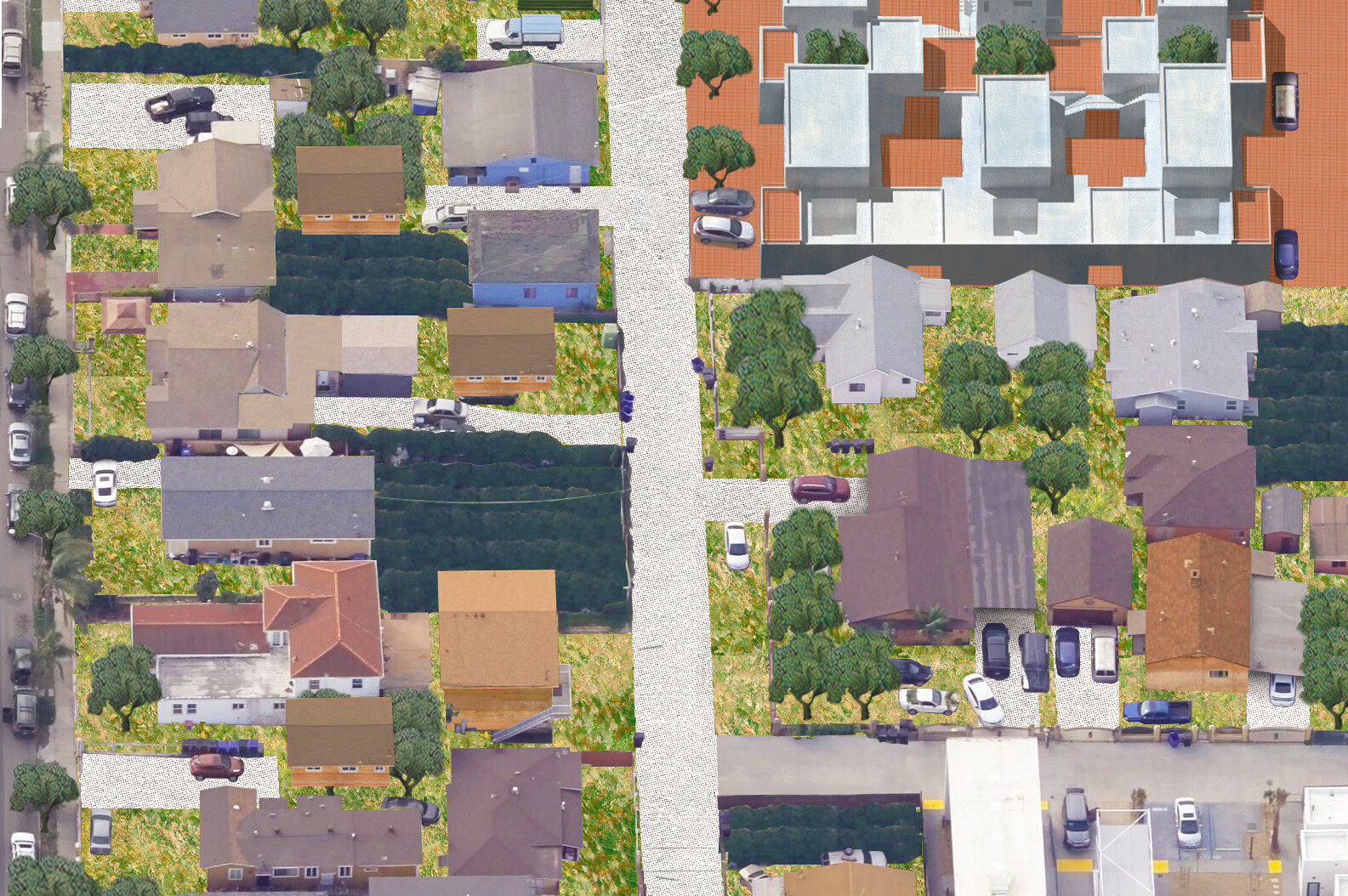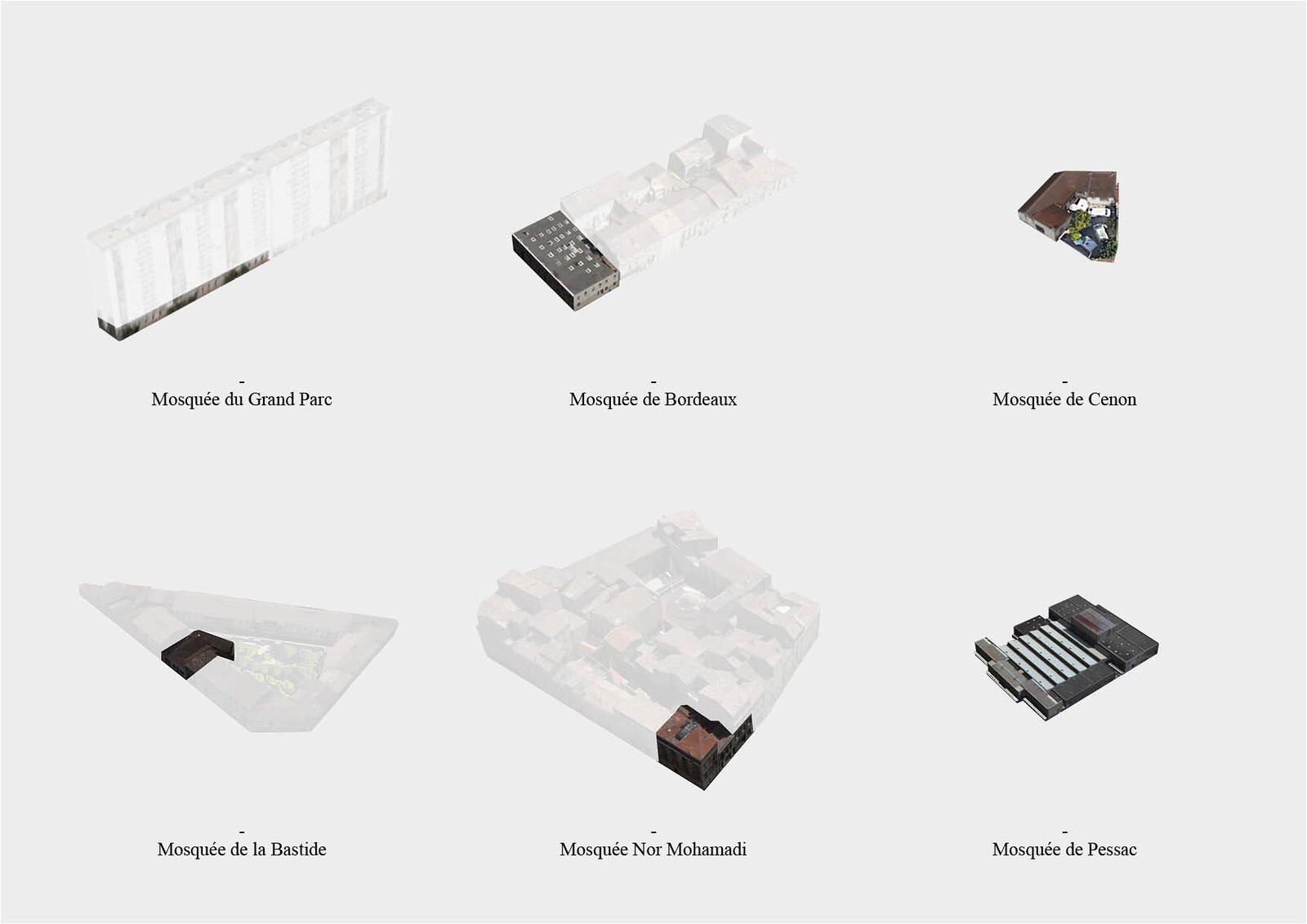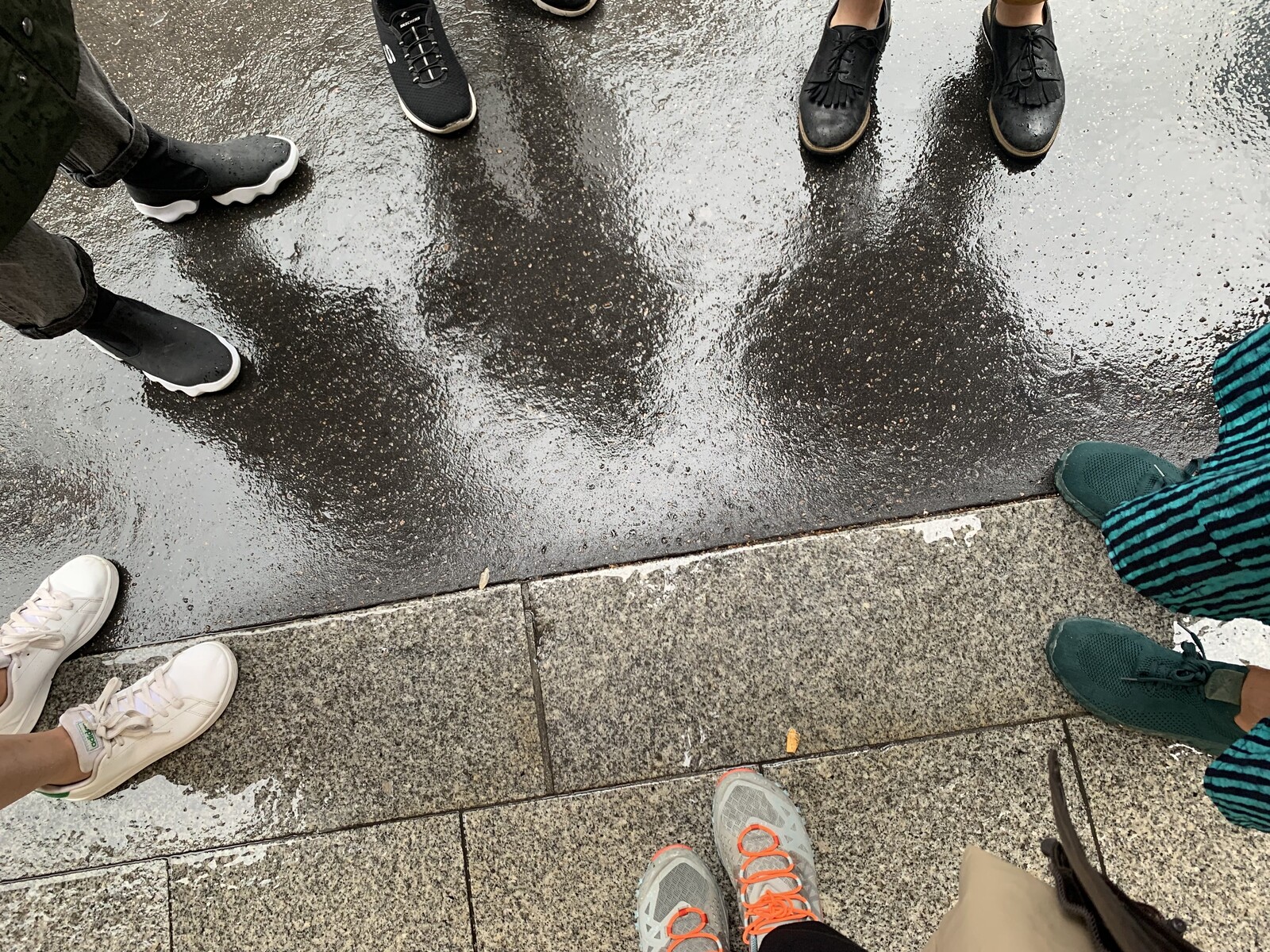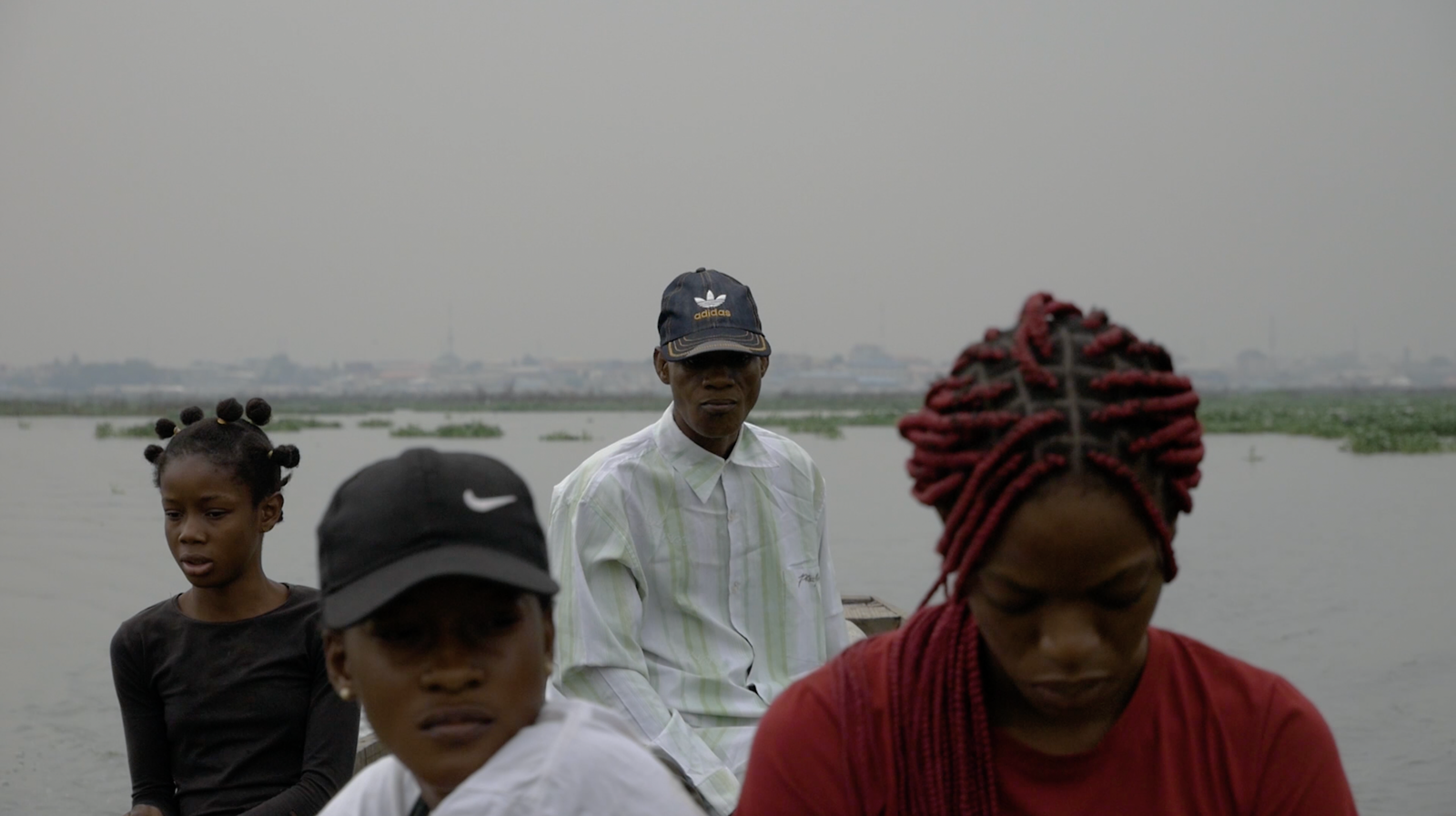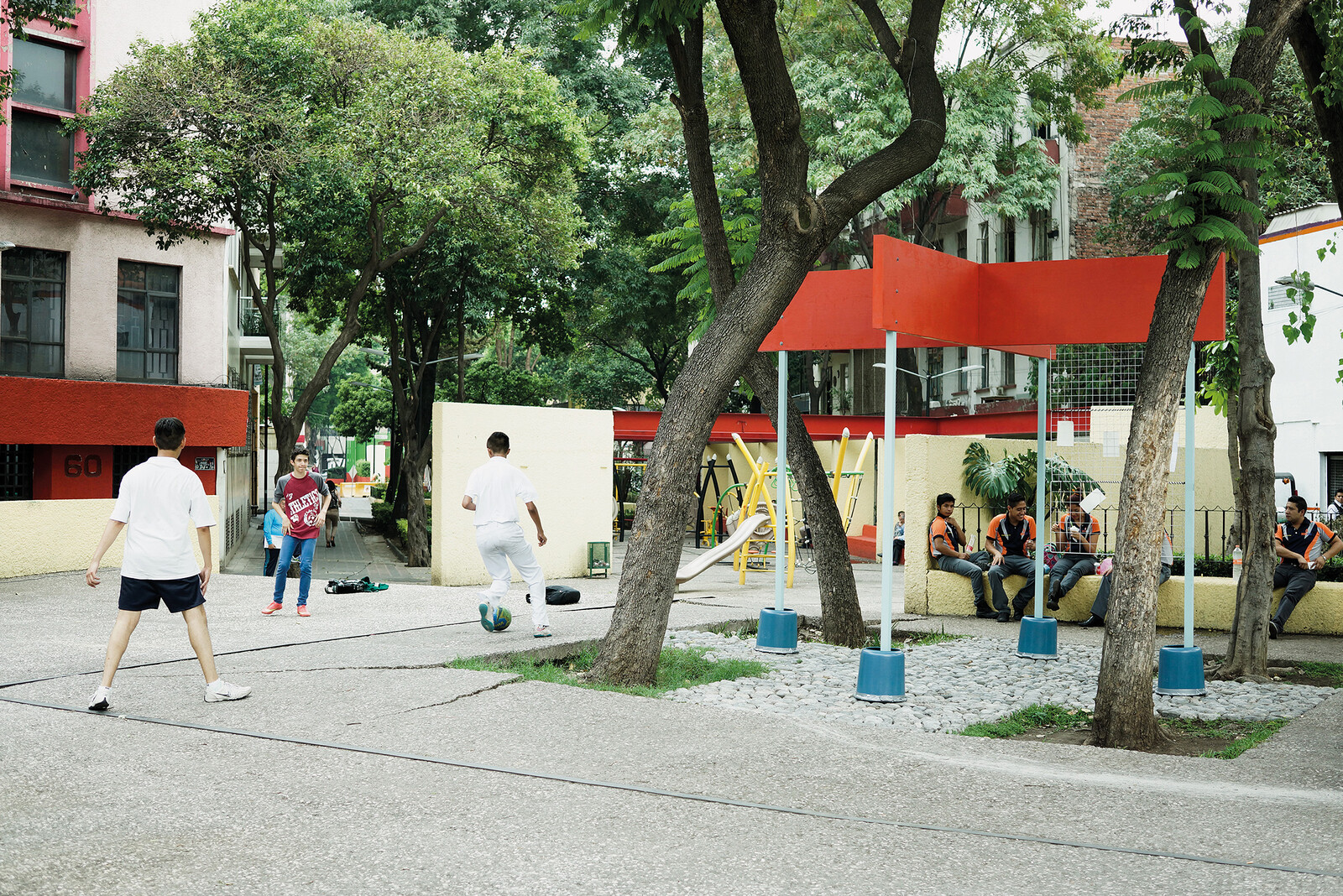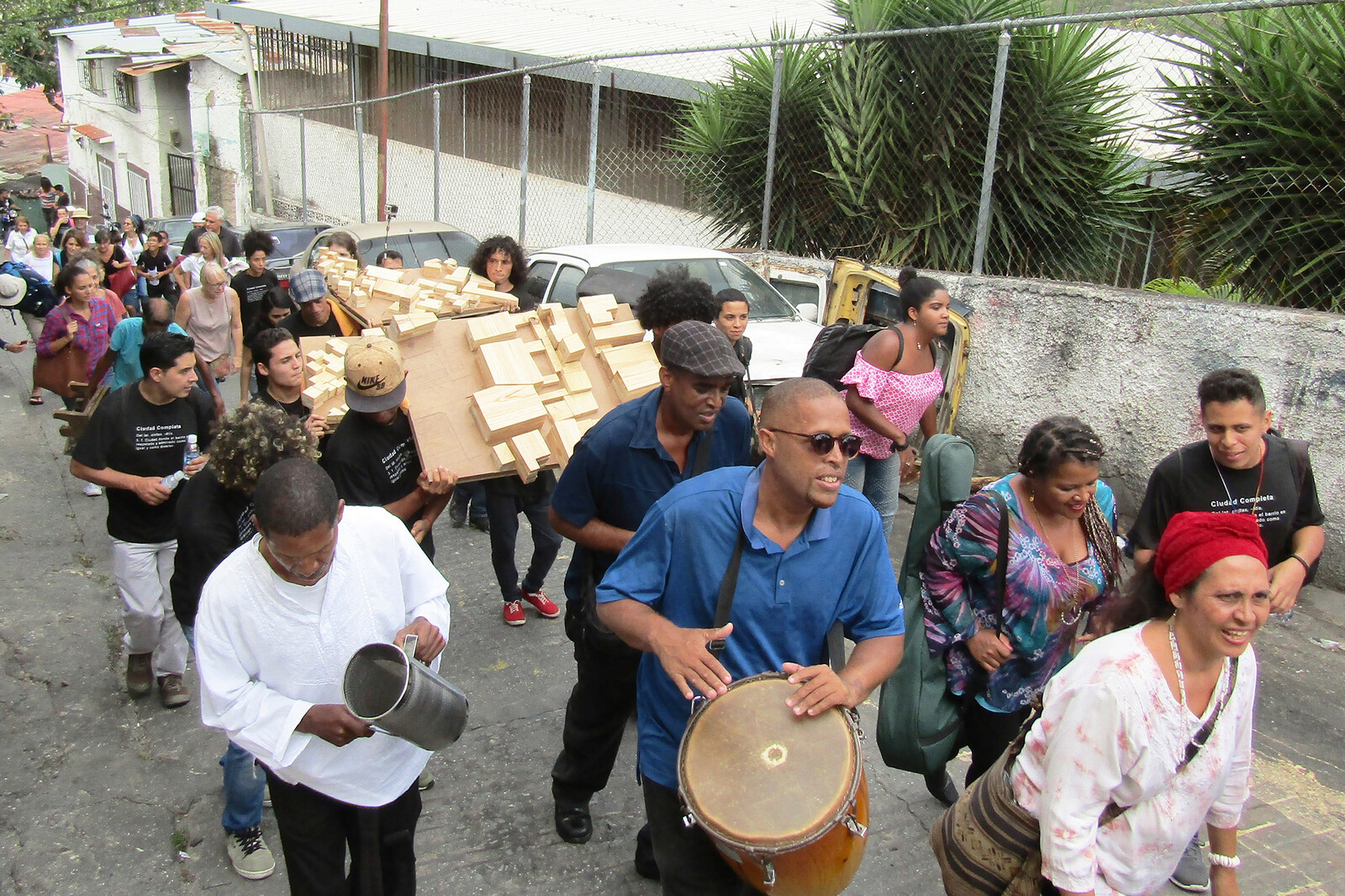What does it take to sustain a collective life powerful enough to stand against the cultural regimes of private property? For many grassroots organizations, it is clear that resistance cannot be achieved only by adopting models of collective property ownership. As more and more cases around the world show, collective life does not simply require a shared space: it also demands the creative production of counter-hegemonic cultural and educational programs capable of cultivating everyday practices of conscious collective resistance. Among the most successful models in Latin America of fostering a life in common across generations, many demonstrate that living beyond the ideology of capitalism can be sustained through an alliance between collective property and popular education.
Two of the most influential movements in the region that have militantly shaped their agendas to collectivize life are the Landless Workers Movement in Brazil (Movimento dos Trabalhadores Rurais Sem Terra, MST) and the Uruguayan Federation of Mutual Aid Housing Cooperatives (Federación Uruguaya de Cooperativas de Vivienda por Ayuda Mutua, FUCVAM). Formally founded in 1984, MST has led the struggle for land democratization in Brazil and is well-known for its network of agro-ecological cooperatives throughout Brazil. And FUCVAM has led the struggle against the commodification of housing, building the largest network of housing cooperatives in Uruguay since its establishment in 1970. From their own situated histories, they both pair claims for collective property with programs of education that ground their movements while forging collective consciousness among members. Their battle is as spatial as it is ideological. While their spatial tactics are a claim to radical alterity, their educational projects are a claim to radical futurity.
Despite their different organizational structures, MST and FUCVAM were shaped by the undercurrents of the Cold War. They were both empowered by a Marxist critique of property that was embedded in a popular liberation theology.1 But as each organization grew, the need to maintain social cohesion beyond their militant origins quickly became clear. As a result, popular education began to take a more central role. As MST and FUCVAM have expanded over the decades, their claim for collective rights against systematic oppression remains clear. These movements put forward the argument that, in order to construct a common world, one must also deconstruct the seeming inevitability of individualism and land profiteering.
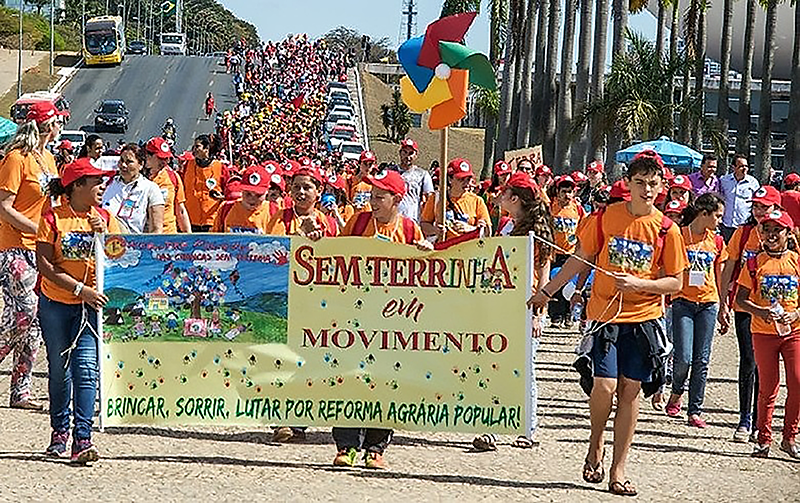

MST kids participating in a march. Photograph by Paulo Pinto, late 1990s. Source: MST education.
Future Collectivities, Itinerant Education
MST’s struggle for land democratization in Brazil exists, resists, and flourishes in a context where one percent of landowners hold possession of half of rural Brazil in latifúndios—vast tracts of rural land owned by the landed elite.2 It is in direct response to these landowners who owned more land than they could cultivate that MST emerged in 1984 to consolidate the fight against the systemic dispossession of the rural poor across Brazil. In the late 1970s, before the group was officially founded, many landless and impoverished rural communities in Río Grande do Sul had already risen up against this socio-spatial order by occupying lands that were left uncultivated. This strategy of land occupation has become the signature tactic of MST to claim land rights for those who work the land. The objective of a non-violent land occupation is to pressure authorities to grant collective rights to MST members, a process that takes time and is not always successful. As a result, many of them have experienced an itinerant life, moving long distances over the course of different land occupations, evictions, and protests.
During its early days, land occupations were inspired by liberation theologians who believed that the faithful should act against social injustice, as well as progressive rural unions that understood their conditions in terms of class struggle.3 Despite state repression and violent attacks against the landless, what began as land occupations in the south of Brazil transformed into an organized social movement to pressure authorities for land reform. And yet, it was not until the movement found a legal counterpart in Article 184 in the Brazilian Constitution of 1988 that it expanded its impact throughout the country. This law opened the door for groups to expropriate land based on the reasoning that it did not perform its “social function.”4
In addition to land occupations and encampments, landless activists in Brazil who paved the way for MST’s emergence in the early 1980s identified the need to cultivate public awareness of their cause.5 The reason for this is twofold: first, it was an effort to raise immediate support for encampments experiencing repression from the military dictatorship; second, and more importantly, it was an opportunity to share with other rural workers across Brazil how the struggle for land was also a means of resistance against the slavery-like conditions of rural labor in latifúndios.6 Through bulletins and popular media, activists achieved the national impact necessary for it to expand into the organized movement that would become MST. By the second half of the 1980s, MST had established itself and begun organizing on a national scale, institutionalizing a variety of “sectors” to attend to the collective life of the movement.7 These sectors were set up to address questions of gender, finance, international relations, and education, among others. Crucial to the ideological and political sustenance of their movement was the foundation of their educational sector in 1987, which oversees most educational programs in camps and settlements, and develops training centers, international educational alliances, and national schools for the movement.8
Temporary encampments have been a crucial space for building collective consciousness.9 It is there, in the state of uncertainty, that the cultivation of allegiance to the goals, symbols, and practices of MST gains crucial importance.10 MST occupations also often involve families with children. The presence of sem terrinha (little landless) in the camps led MST’s educational sector to pressure the state to provide their kids an education that is not the typical public school curriculum, but rather an alternative educational program that complements their values and principles of collective life.
One of the results of this is known as Escola Itinerante, or Itinerant Schools—“itinerant” because they are specifically conceived to operate within MST camp sites that have not yet achieved collective land rights. In other words, schooling continues amidst the experience of collectively seeking and pursuing land rights. The first of these schools opened in Río Grande do Sul in 1996 to address the right to education of the sem terrinha. Itinerant Schools offer the equivalent of K–12 education to MST children. Schools are co-managed between the encampment and the authorities: the government is responsible for covering teacher salaries through temporary contracts and providing basic infrastructure, from chairs to pens, while MST is responsible for recruiting and training teachers, and supporting them in developing a general curriculum that gets adapted to the specific needs and context of each encampment.11
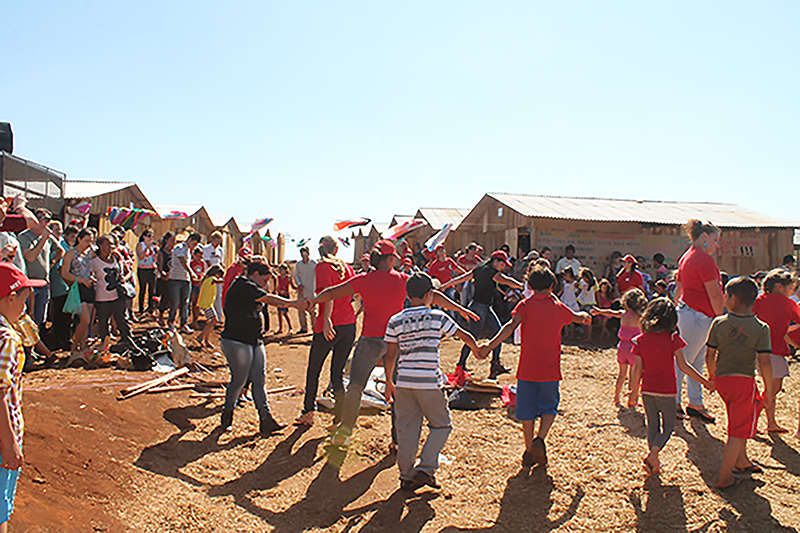

Opening celebration of Itinerant School Herderiros do Saber (Heirs of Knowledge) in the MST encampment Herdeiros da Terra de 1º de Maio, Rio Bonito do Iguaçu, Paraná. Photograph by Carla Loop, 2014. Source: MST.
Their curricula draw from numerous models of popular education, including the 1920s model of the “commune school” by Soviet pedagogue Moisey Pristrak, the 1961 Cuban literacy campaign, and Paulo Freire’s pedagogies of liberation.12 Freire’s understanding of education as “the practice of freedom” has been one of the most foundational ideas for Itinerant Schools, which emphasize his call to attend to the conditions of the oppressed by connecting all subject matters required by the state (math, geography, science, history, etc.) directly to life in the camps and to sociopolitical events that are relevant to the collective life of the students.13 In this way, the fight for agrarian reform, the spatial conditions of the camp, issues of food security, and other topics that draw on the collective material and social realities of the encampments all become part of students’ public education.14
To complement the curriculum, and drawing from Pistrak’s model, Itinerant Schools also include collective manual labor activities.15 Students participate in the management, maintenance, and organization of their own school. Depending on the age, students form or join work collectives to share responsibilities like decorating the school, monitoring student and school hygiene, attending to the school garden, producing the school newspaper, documenting the school’s pedagogical practices, helping teachers in lesson planning and organizing educational material, deciding on budget expenditures, and even organizing extra-curricular activities.16 This inclusion of collaborative work not only promotes a sense of collective identity crucial to MST principles, but also proposes a formation that rejects socially constructed hierarchies between teachers and students. As MST member Alessandro Mariano and scholar of its educational platforms Rebecca Tarlau have argued: “For the MST, these are critical lessons, as the hope is for the youth to become active members of the governance of the camp, and also begin to participate in the regional and state-wide thematic work sectors that sustain the movement.”17 From the very beginning, it is clear that sem terrinha are at the core of the future of their movement.
The ability for the schools to follow the community wherever they go is only possible by the physical mobility of the schools themselves. Most Itinerant Schools can operate in the Brazilian climate simply under the shade of a tree or through simple makeshift structures. Yet despite the lack of any clear architectural model for the classroom, kids have a strong relation to the collective spaces and land in the camps through their involvement running them. MST’s claim to futurity lies at the intersection of struggles for collective property and a pedagogy that centers on the formation of collective consciousness. As Isabela Camini, a member of the MST education sector who has followed the evolution of these schools since the 1990s, writes: “In this educational experience, the struggle and the construction of a new life go together, the dream of creating consciousness of the conditions of the oppressed and the search for emancipation of the people was achieved simultaneously.”18
By 2008, around 4,600 students had benefitted from the educational offering of MST’s Itinerant Schools. This is also the year when Itinerant Schools were subjected to greater governmental scrutiny, which, despite opposition by MST, led to the closure of many. According to Tarlau, the closure of the schools was part of an “attempt to weaken the MST’s influence in the state or, in Gramscian terms, a frontal attack on the movement.”19 Without Itinerant Schools, kids in MST’s temporary encampments are required to travel long distances to attend city schools, which has had the effect of indirectly pressuring the landless to reconsider their occupations.20 Today, Itinerant Schools are only fully operational in the state of Paraná. But, for as long as these schools continue, they not only fulfill the right to education for MST children, they also serve as counter-hegemonic pedagogical tools laying the ground for alternative collective futures.
Political Formation, Collective Legacies
Often described as the movement of the urban landless, FUCVAM coordinates, advocates, and promotes access to collective land and housing for the working poor throughout Uruguay.21 Since its foundation in 1970 during the 5th National Meeting of Housing Cooperatives in Florida, Uruguay, FUCVAM has promoted a model of housing cooperative based on four principles: (1) collective ownership as a way to resist real estate speculation—houses are owned by the cooperative, but members have the right to use and enjoy their houses and can pass them from one generation to another; (2) mutual aid as a way to build the cooperative and join efforts to access loans—cooperative members can apply for a low interest loan by committing to work for an average of twenty-one hours per week in the construction of their own houses; (3) technical assistance as a way to maximize the quality and size of their houses—cooperatives are encouraged to work with architects and technical teams throughout the construction process; and (4) direct democracy as a way to involve the entire community on equal terms—members have full control of the management of their cooperative before, during, and after construction through collective decision-making practices.22
These principles of collective spatial production were, to an extent, inspired by the first housing cooperative in Uruguay. Cooperativa Isla Mala, which was built between 1966–1970 in the town of Veinticinco de Mayo, served as a crucial reference for the legislation of housing cooperatives through Law 13728, otherwise known as the National Housing Law of 1968. This law transformed housing welfare relations in Uruguay by providing clear legal, financial, and technical measures to facilitate the establishment of housing cooperatives founded on collective property and principles of mutual aid.23 In this context, FUCVAM emerged not only to consolidate the wide interest in housing cooperatives and mutual aid but, more importantly, to address the needs of those who experience dispossession and live life on the margins of society.
In its early days, FUCVAM brought together about 2,000 members, most of whom were related to labor syndicates, workers unions, and working-class trade organizations. Most of these initial members were politically aligned with the ongoing work of progressive Uruguayan activists, Marxists, and leftist liberation theologians. FUCVAM originally described itself as “a movement for workers by workers,” and took pride in contrasting its social agenda with that of the ruling conservative government, which had largely abandoned the poor.24
From the outset, FUCVAM challenged the notion of “marginality,” arguing instead that marginality operates as a myth constructed through capitalist exploitation to naturalize social relations of dominance.25 The organization therefore sought not only to provide “solutions” to the material needs of those experiencing dispossession, but to do so by empowering the working classes to construct an alternative social space through collective property founded in principles of solidarity. Collective property, in this sense, is not just a means to provide housing, but the necessary material condition for advocating for a dignified position for the working classes in a capitalist context. As their anthem claims, “housing is only the beginning, not the end.”26
Throughout its history, FUCVAM has encountered much political opposition, from the repression of the cooperative movement during the dictatorship between 1973–1985, to its fight for collective land rights in the late 1980s and early 1990s.27 Despite this, it has consistently grown and achieved clearer paths to collective land rights for its members.28 However, as much as FUCVAM has expanded its organizing base, in the last two decades—a period in which neoliberal economic policies have done great damage to the power of collective labor action—its membership of more than 30,000 families has become increasingly composed of people who share not a particular political alliance, but only a common lack: housing.29
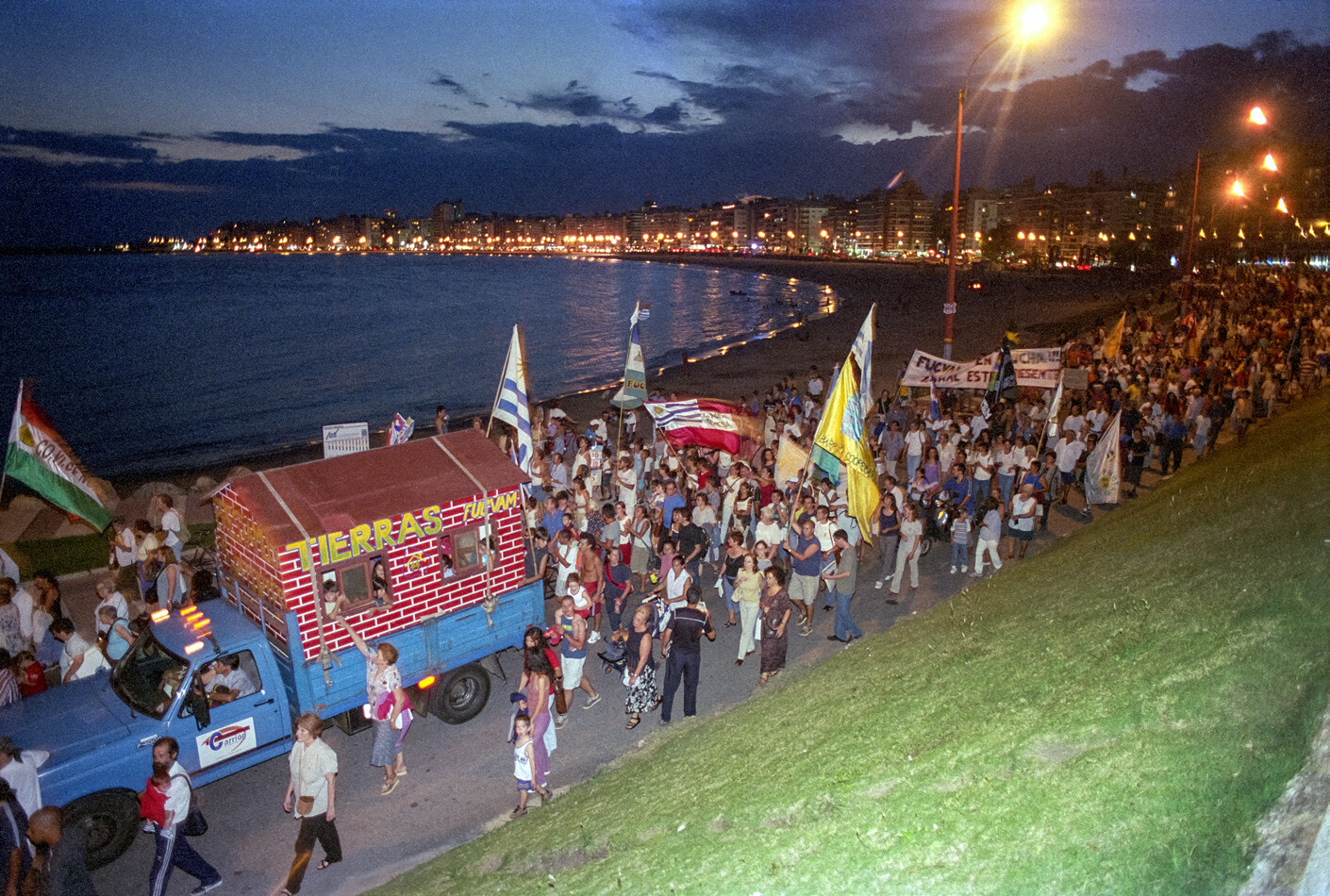

FUCVAM demonstration in Pocitos, Montevideo. February 2002. Photograph by Gustavo Castagnello, FUCVAM.
This transition highlights the need for FUCVAM to match its spatial program with an ideological one. If FUCVAM requires its members to self-build their houses collectively through mutual-aid practices, the maintenance of their houses and the sustenance of their cooperative movement against the commodification of space demands that they maintain social cohesion across generations.30 Their spaces, just like their movement, cannot exist without a social bond that grows over time. Like MST, becoming a FUCVAM member is to enter into a social relation that has no finite temporality. While the cooperative owns the houses, the right to use them can be passed from one generation to another. But, while intergenerationality may be a value built into the legal framework of collective property, it is not a guarantee to maintaining the critical historical consciousness so necessary for the movement and its daily reproduction.
In the words of pedagogue and FUCVAM activist Alicia Dambrauskas, “cooperativists are not inborn, they are forged.”31 Dambrauskas’s claim speaks to the challenge of constructing collective consciousness under late capitalist conditions and its individualizing tendencies. Thus, the challenge is to maintain the values of cooperation and mutual aid across generations and everyday. While many members speak about being part of a cooperative as an educational process in and of itself, FUCVAM makes efforts to promote a cooperative education for kids that exists alongside the public school system that many of their kids attend, and whose curricula often demeans crucial elements of collective living, from the need to work collectively to the possibility of cultivating a collective imaginary.32 For Dambrauskas, you cannot maintain a collective space built on care, mutual aid, and solidarity without forging these values in future generations. With this ambition, in 2003 Dambrauskas established an afterschool educational program called Maestro/a de la comunidad (“Community Teaching”), which forges future commoners through a creative, collective, and work-based form of education.33
According to Dambrauskas, the program’s educational model draws on collective work by Soviet pedagogue Anton Makarenko, as well as the belief in centering educational practices around the interests and spaces of students set forward by French pedagogue Celestin Freinet.34 Common to both is the removal of power and authority from teachers, instead offering an open platform for students to propose and drive their own communal projects. The idea is that, through collective work, practices of collective decision making and cooperation naturally emerge.35 In 2003, FUCVAM ran the experimental phase of the project in three different housing cooperatives—two in Montevideo (COVIFU and COVIPASO) and one in Flores (joining COVAMF and COVIF II).
FUCVAM’s afterschool program takes the entire community as its classroom; the output is not a productive worker, but a creative collective whose labor is dedicated to building new social institutions within the cooperative. Each afterschool program emerges out of an in-depth study of the socio-material realities of the cooperative. Teachers interview the children, learn about the history of the cooperative and its members, and analyze its spatial characteristics, its uses, and its immediate context. Only then can the teacher engage the community and decide collectively on the form that the project is to take. Cooperative COVIFU, for instance, decided to structure their collective learning around the creation of a library, while COVIPASO decided to produce a newspaper, and COVAMF and COVIF II started an allotment garden.
All of these activities or spaces open avenues for guided learning. They are also, and perhaps most importantly, social institutions that can only survive through collaboration, collective decision making, and continuous care—essential elements for a life in common. The library in COVIFU, for instance, is run by the kids, but was kept alive through the promotion of activities that incorporated everyone in the cooperative. Through activities like organizing book donations, the kids reinvigorated the importance of oral collective histories and intergenerational knowledge, inviting elders to speak about their histories and shared struggles, writing stories and books, and organizing workshops and activities relevant to other members of the cooperative. What began as a library turned into a vibrant space that not only allowed kids to experience the collective creation and management of a common project, but also strengthened historical consciousness across different generations in the cooperative.36 While this program could not continue beyond its experimental phase due to the lack of funds, the program left an indelible mark on the community. And, among all, it established loudly and clearly the argument, as Dambrauskas states, that “To live in community demands education”37
Undoing Property, Reclaiming Futures
The educational efforts of both FUCVAM and MST demonstrate their commitment to the political formation of their members as a direct path to the collective production of space. The pursuit of critical consciousness cannot undo the logics of private property, its wider logics of displacement, or its effects on the most vulnerable. Popular education can, however, offer a tool to co-create and co-sustain socio-spatial alternatives to life under capitalism. It has the capacity to energize both the collective imagination and empower individuals to pursue a life in common. Yet this is only effective if popular education becomes a living pedagogy, one that exceeds the meeting, the reading, the course, the conversation, the uprising; it must live in the commitment to continuous struggle; among the laughs, play, collective enjoyment, and solidarity. Popular education not only exists in the consciousness of the communities that embrace it, but also in the practices of maintaining and reproducing collective space. Life in common is thus never achieved by a single act; it cannot be reduced to the proclamation, the deed, the title, or the registration. For as long as the world is organized by capitalism, a life in common will exist only as a continuous act of resistance. Collective consciousness among future generations is crucial here, in teaching us that we do not simply have to resist our immediate contextual conditions, but that we have a collective responsibility to build an emancipatory future. As popular education makes clear, for collective property to remain, it must live among others, across generations, and in solidarity.
Liberation Theologians are often considered the leftist branch of the Christian church. Their ideology was, in part, influenced by the call to update the Catholic Church during the Second Vatican Council (1962-1965) that encouraged Christians to build solidarity with the oppressed and those in marginal contexts. In Latin America, crucial to the dissemination of liberation theology was the work of Gustavo Gutiérrez and the gatherings in 1968 in the framework of the “Conferencia del Episcopado Latinoamericano” (CELAM) in Medellin, Colombia. See: Gustavo Gutiérrez. Teología de la liberación: Perspectivas (Lima: Universidad de Lima, 1971); as well as Pope Paul VI, Gaudium Et Specs, Rome, December 7, 1965.
Júlia Dolce, “Popular Agrarian Reform and the Struggle for Land in Brazil,” The Tricontinental, Dossier No. 27, April 3, 2020. For an account of the various historical processes that led to land concentration in Brazil by an elite landed class, see: Leandro Vergara-Camus, “Peasant struggles and primitive accumulation,” in Land and Freedom, (London: Zed Books, 2014), 43-46, 50-56.
For more on the relation between the landless and the church see: Ivo Poletto, “Churches, the Pastoral Land Commission, and the Mobilization for Agrarian Reform,” in Challenging Social Inequality. The Landless Rural Workers Movement and Agrarian Reform in Brazil, ed. Miguel Carter (Durham: Duke University Press, 2015), 88-111; Gabriel Ondetti, Land, Protest, and Politics: The Landless Movement and the Struggle for Agrarian Reform in Brazil (State College, PA: Pennsylvania State University Press, 2008), 52-54. Crucial in this regard is the role of the Pastoral Commission of Land (CPT) founded in 1975.
See “Title VII, Chapter III,” Agricultural and Land Policy and Agrarian Reform, Articles 184 through 191 of the Constitution of the Federative Republic of Brazil 1988, amended in 2010.
For a crucial account of the emergence of MST in relation to popular educational practices, see: Isabel Camini and João Pedro Stedile, “Paulo Freire’s Meeting with the MST,” Friends of the MST, 2021. See ➝.
See the role of the MST’s communication sector in Miguel Carter and Horacio Martins de Carvalho, “The Struggle on the Land: Source of Growth, Innovation, and Constant Challenge for the MST,” in Carter, ed., Challenging Social Inequality, 257.
Ondetti, Land, Protest and Politics, 98-101, 116.
Among the most important educational initiatives for MST activists are CEPATEC (Centro de Formação e Pesquisas Contestado), their first training center, located in Santa Catarina; Instituto Técnico de Estudos e Pesquisas da Reforma Agrária (ITERRA); and, since 2005, the Florestan Fernandes National School (ENFF / Escola Nacional Florestan Fernandes). For a comprehensive account on the educational sector of MST, see: Rebecca Tarlau, Occupying Schools, Occupying Land: How the Landless Workers Movement Transformed Brazilian Education (New York: Oxford University Press, 2019).
Ondetti, Land, Protest, and Politics, 114.
As political theorist Gabriel Ondetti argues, “if {MST members in temporary encampments} could be made to understand the deeper, radical purpose of the MST, they would be more likely to resist cooptation and repression and to remain committed to the MST’s struggle once they gained land.” Ondetti, Land, Protest, and Politics, 114.
Alessandro Mariano and Rebecca Tarlau. “The Landless Workers Movement’s itinerant schools: occupying and transforming public education in Brazil,” British Journal of Sociology of Education 40, no. 4 (2019): 544.
For a discussion on these influences, see: Ondetti, Land, Protest, and Politics, 71.
“The insistence that the oppressed engage in reflection on their concrete situation is not a call to armchair revolution. On the contrary, reflection—true reflection—leads to action … As they {the oppressed} attain this knowledge of reality through common reflection and action, they discover themselves as its permanent re-creators.” Paulo Freire, Pedagogy of the Oppressed (New York: Continuum. 2005), 66, 69.
Alessandro Mariano and Rebecca Tarlau emphasize the importance of “collective classroom planning” in the inclusion of “portions of reality” in the classroom. Teachers plan together by making an “inventory of reality” that collects and organizes the multiple topics and spaces that will be discussed during the academic year. See: Mariano and Tarlau, “The Landless Workers Movement’s itinerant schools,” 546.
On Mosey Pristrak in relation to MST, see: V.A. de Oliveira Feitosa, A.M. de Araújo Stedile, M.C. da Silva Barroso, and R. Alves Feitosa, “Moisey Pistrak (1888-1937) and the Unified Labour School: Analysis of Soviet Pedagogical Thinking for the Education of the Homo Novus,” Journal for Critical Education Policy Studies 19, no. 1 (May 2021); Tarlau, Occupying Schools, Occupying Land, 71.
Among the most common extra-curricular activities included throughout all MST educational programs is mística. Mística is an important practice in liberation theology. It aims to cultivate symbolic representation through songs, chants, poetry, speeches, stories, theater, samba, etc.
See: Mariano and Tarlau, “The Landless Workers Movement’s itinerant schools,” 552.
Isabela Camini, “Paulo Freire y la Escuela Itinerante del MST,” Decisio 55 (Sept 2020-April 2021), 66. Translation by author.
Tarlau, Occupying Schools, Occupying Land, 198.
Rebecca Tarlau describes this as “scare tactics” exerted by the government to intimidate many landless communities.
Benjamín Nahoum and Gustavo González, Escritos sobre los sin tierra urbanos: Causas, propuestas y luchas populares (Montevideo: Trilce, 2011), 49-96.
FUCVAM, Declaración de Principios, Asamblea Nacional, Paysandú, November 1999. Please note that I have added my emphasis here. FUCVAM outlines: collective property, mutual aid practices, direct democracy and self-management. I have however, included the latter within the principle of direct democracy and included technical assistance as it is present in every FUCVAM cooperative and required by law.
The law was approved on December 17, 1968, under the presidential administration of Jorge Pacheco Areco. While the articles dedicated to housing cooperatives in Chapter X have created many legal mechanisms to expand access for the urban poor, at the time it was considered a strategic anomaly by a conservative government interested in polarizing society. To consult Chapter X of Law 13728 see: Benjamin Nahoum and Heriberto Duverger Salfrán eds., Las Cooperativas de Vivienda por Ayuda Mutua Uruguayas: Una historia con quince mil protagonistas (Andalucia: Junta de Andalucía, 1999), 203-222. The law was in part drafted by architect Juan Pablo Terra, see: Juan Pablo Terra, Proceso y significado del cooperativismo uruguayo (Montevideo: Arca Editorial, 1986).
FUCVAM, “Propositos y Objetivos de la F.U.C.V.A.M.,” Boletín no. 1 (March 1971).
“El mito de la marginalidad,” La Reforma Urbana, Va!, Asamblea Nacional Extraordinaria, XXVI (February 1991), 6.
“Himno de las Cooperativas,” written and composed by Ruben Olivera, 1982.
Two moments are crucial in this respect: FUCVAM’s nation-wide mobilization against the privatization of cooperatives proposed by the dictatorship in 1984 and the land occupations of 1989 throughout Montevideo that pressured the government to grant collective land rights to cooperatives in formation. For more see: Gustavo González, Escritos sobre los sin tierra urbanos, 49-72.
In regards to collective land rights, it is crucial to remember the role of FUCVAM in advocating for the institutionalization of an official land portfolio (“Cartera de Tierras”) to facilitate access to land for the working classes. For more see: Junta Departamental de Montevideo, “Cartera Municipal de Tierras para Vivienda,” Decreto 24654, 1990; Benjamín Nahoum, “Cartera de tierras: una sociedad por la ciudad,” Escritos sobre los sin tierra urbanos, 123-132.
Belén Riguetti and Gustavo González. “50 años de FUCVAM: más de 30.000 familias accedieron a una Vivienda por el Sistema de ayuda mutua,” La Diaria, July 6, 2020. See ➝.
For more information about the process and time involved in mutual aid and self-construction within FUCVAM, see: Benjamín Nahoum, “Horas funcionales, ¿sí o no?,” in Algunas Claves: Reflexiones sobre aspectos esenciales de la Vivienda cooperative por ayuda mutual (Montevideo: Trilce 2013), 125-128.
Alicia Dambrauskas, “Educación cooperative autogestionaria,” We Effect América Latina, Ciclo 1, Curso de formación COCEAVIS. See ➝.
Mariana Menendez, Educación en movimiento, unpublished Master’s degree thesis (Nov 2014), 82: “Lo interesante es que la totalidad de la accionar de las cooperativas y la federación es en sí mismo un proceso educativo” (entrevistado B, dirigente nacional, etapas 2 - 3, Abril, 2014).
Alicia Dambrauskas, Proyecto: El maestro de la comunidad (FUCVAM: Comisión de Desarrollo Social: Departamento Infancia Cooperativa, 2003).
Alicia Dambrauskas, “En clave de ‘Y’: educación y trabajo, trabajo y educación,” Revista Temas de Profesionalización Docente, no. 4 (2020).
Dambrauskas, “En clave de ‘Y.’” Among other influences on the idea of collective work as education, Dambrauskas names: Miguel Soler, Julio Castro, Pedro Figari and Arturo Ardao.
Alicia Dambrauskas, El maestro de la Comunidad II: La puesta en marcha de la experiencia—El salto de la idea a la acción (FUCVAM: Comisión de Desarrollo Social, 2004), 13.
Alicia Dambrauskas, Proyecto, 15.
In Common is a collaboration between e-flux Architecture, the Chicago Architecture Biennial, UIC College of Architecture, Design, and the Arts, and arc en rêve within the context of its exhibition “common, community driven architecture.”
